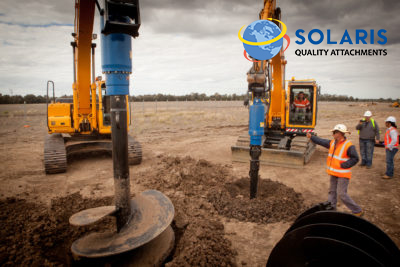
Even if you are an experienced construction professional, it can be difficult for you to find out exactly what equipment you need. When deciding the right kind of auger bit for your ground, you need to differentiate between the various different types and their applications.
Types of Auger Drills
Auger drills, also known as auger bits or earth drills, are tools used for drilling and excavating the ground. Selecting the right kind of auger bit for the ground is important.
Auger bits can be designed for a large range of excavators, skid steer loaders, mini loaders, and truck cranes and are suited for machinery weighing from 750kg to 50 tons. The auger drills come in a wide range of sizes as well, ranging from 7 inches in diameter and 18 inches in height to over 30 inches in diameter and 73 inches in height.
If you are using compact equipment or a vehicle, it is important to take into account three different elements: the auger bit, the auger drive, and the mounting plate.
Auger Bits for Ground Types
If you do not have the right size auger bit for the job, not only will it result in poor performance and inefficiency, but it might also damage the auger bit and cost you a lot of money getting a replacement. That is why it is crucial to ensure that the auger bits you have ordered are the right type for the job, and if they are not, you can easily switch them for one that will get the job done.
One of the biggest factors in determining the right auger bit is the ground type you need to drill into. Earth drills are meant to dig into the dirt, rocky earth, shale, asphalt, fracturable rock clay, and even permafrost. Depending on the extent of the job, you can also use a variety of different earth drills. For example, you can use an earth/rock bit to dig the earth, or you can use a rock bit to dig shale or asphalt.
Speed of the Auger Bit
When choosing your earth drill, it is essential to keep the right drilling speed in mind since it will vary based on the type of auger you select as well as the surface you are drilling into.
If you are using an earth drill to dig a hole in the earth, then the optimal rotational speed will be between 55 to 65 RPMs. However, if you are using the same drill to dig into clay, you will need to go at a slower speed of around 44 to 55 RPMs. And if your project requires the use of a rock earth drill bit to dig into dense rock, then the rotational speed will be the lowest and should not typically exceed 25 RPMs.
When using an auger bit, it is important to ensure that the operator has the right training and experience to do the job with care and precision. If not, it can increase the risk of injury to the construction crew and damage to the auger bit.
Want to know more about auger bits for the type of project you are working on? Visit Solaris Attachments or call us at 8887543609 to discuss your unique project with us and order an earth drill suitable for the job.
